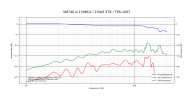Bob from Florida
Major Contributor
- Joined
- Aug 20, 2020
- Messages
- 1,286
- Likes
- 1,180
Please read this link https://hub.yamaha.com/audio/music/what-is-dynamic-range-and-why-does-it-matter/One more thing. I made a fair number of recordings of orchestral music. I also have been collecting recordings of orchestral music for over 50 years. There's a number of sonic differences between "Golden Age Stereo" recordings, like the RCA Victor "Living Stereo" series and the Mercury "Living Prescence" series and modern digital recordings of orchestral music. I collected Shaded Dogs and MLP recordings on vinyl, CD and SACD. There's a thickening and smoothing of texture in these old recordings. The sounds of massed strings on these recordings, or the sound of string sections on record from 1954-1970, are nowhere as open as reality or digital recordings of the same. Big difference between the monolithic sound of vintage stereo and the far more diffuse and delicate sound of reality. These old recordings had their dynamics adjusted on the fly via gain riding, where a tech reads a score and adjusts level accordingly. The recordings tended to have the levels pushed hard to override the self-noise of the analog tape.
Harry Pearson and the notion of "The Absolute Sound" pointed to these recordings as the absolute state of the art. But production decisions limited the potential dynamic range of these recordings. The levels of distortion on these recordings are quite high, particularly in the peaks. But people with limited exposure to the real sound of the orchestra would compare a digital production, without the distortion or limiting of the "Golden Age" recordings and come to the conclusion that an accurate representation of orchestral sound is wrong.
An important bottom line to note: CD sales were first driven by Classical music, where the virtues of Digital record/replay are more important than with pop music. Having over an hour of continuous playing time could cover the durations of most classical compositions. IGD---inner groove distortion---is more of a problem with classical music than pop as the dynamic peak of most Classical music comes at the very end of a work and IGD is worst just before the deadwax. And the self-noise of LPs is a bigger problem with music of wide dynamic range than the usually highly compressed sound of most pop music.
Orchestral music is one of the big reasons for CD's initial sucess. Classical music lovers, for the most part, voted with their wallets. CD won.
If you can't wade through the whole thing the relevant highlight is below.
--------
DYNAMIC RANGE AND MUSICAL GENRE
All music has some degree of level fluctuation, but some genres tend to have broader dynamic ranges than others. Recorded pop, rock, R&B, hip-hop and country music usually have a relatively modest dynamic range — typically around 10 dB, although there are exceptions. Electronic dance music (EDM) probably has the smallest dynamic range — often in the 6 dB neighborhood — but makes up for it by creating contrast with its almost infinite array of instrument colors and textures coming from synthesizers and samplers.On the other end of the spectrum are jazz and classical music, which can have considerably large differences between their quietest and loudest parts. In jazz, uptempo songs typically go from loud passages played on brass and saxophone instruments to quiet piano and bass solos. Even in jazz ballads, the dynamic range is usually relatively wide. A study of dynamic range in different musical styles conducted in 2016 revealed that dynamic ranges in jazz generally varied from 13 dB to 23 dB.
As a group, classical recordings have the widest dynamic range of any genre. The same study cited above found that recorded classical music typically offers between about 20 dB and 32 dB of dynamic range. While that might seem like a lot, it’s still quite a bit smaller than that of a live symphony orchestra performance, which can be as large as 90 dB.
-------
So, while live orchestra music can have large swings the actual recording does not by a large margin. Since the dynamic range of CD's - 96 db - is never approached - max 32db - the vinyl max of 60 db is more than sufficient. As you mentioned the actual recording itself - how it is mastered is the real key.
If I may point out - all this bashing towards vinyl or digital is basically horse manure. The key is the recording with adequate playback electronics for sources (turntable, tape, or digital) and destination (speakers and room).

